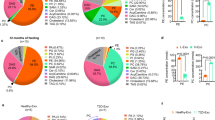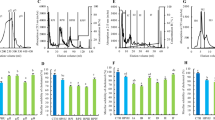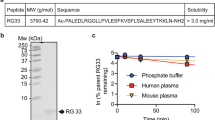Abstract
OBJECTIVE: Previous in vitro experiments, as well as acute assays in rat showed that the C-terminal domain (CT-domain) of porcine pancreatic lipase behaves as a potent specific noncovalent inhibitor of pancreatic lipase. Nevertheless, the potential use of the CT-domain as a therapeutic tool against obesity in humans requires further investigation and would be best achieved using the human CT-domain. In the present study, we investigated the inhibitory effects of the recombinant human CT-domain, in vivo, upon chronic administration to rats fed a high-fat diet.
DESIGN AND MEASUREMENT: The long-term in vivo study requiring relatively high amounts of the human CT-domain, the domain was overexpressed in Escherichia coli as inclusion bodies and an efficient refolding protocol was designed. The inhibitory effect of the recombinant human CT-domain on the activity of pancreatic lipase from different species was first investigated in vitro. Then chronic assays were performed for 4 weeks in rats fed a high-fat diet with or without a daily dose of 1.2 mg of CT-domain per kilogram rat. The time course of food intake, body weight, plasma parameters, liver lipids, faecal output of fat and total cholesterol were measured.
RESULTS: A high yield of correctly folded recombinant human CT-domain was obtained using our refolding process, as evidenced by the capability of the recombinant domain to inhibit human horse and porcine pancreatic lipases in vitro. The recombinant human CT-domain had no influence on the food intake, but significantly reduced the body weight gain. As compared to control rats, higher amounts of total fat (mainly triglycerides and monoglycerides) and total cholesterol were found in the faeces of the rats treated with the CT-domain. Finally, a decrease in liver triglycerides and nonesterified cholesterol was observed while no significant effect could be detected on the plasma parameters.
CONCLUSIONS: These results demonstrated that the CT-domain efficiently reduces in vivo, lipolysis and subsequently body weight gain in rat fed a high-fat diet. The CT-domain could, therefore, be effective in preventing obesity.
This is a preview of subscription content, access via your institution
Access options
Subscribe to this journal
Receive 12 print issues and online access
$259.00 per year
only $21.58 per issue
Buy this article
- Purchase on Springer Link
- Instant access to full article PDF
Prices may be subject to local taxes which are calculated during checkout




Similar content being viewed by others

References
Lairon D, Borel P, Termine E, Grataroli R, Chabert C, Hauton JC . Evidence of a proteinic inhibitor of pancreatic lipase in cereals wheat bran and wheat germ. Nutr Rep Int 1985; 32: 1107–1113.
Satouchi K, Matsushita S . Purification of a lipase inhibiting protein from soybean cotyledons. Agric Biol Chem 1976; 40: 889–897.
Shimura S, Tsuzuki W, Kobayashi S, Susuki T . Inhibitory effect on lipase activity of extracts from medicinal herbs. Biosci Biotechnol Biochem 1992; 56: 1478–1479.
Han LK, Kimura Y, Kawashima M, Takaku T, Taniyama T, Zheng YN, Okuda H . Anti-obesity effects in rodents of dietary teasaponin, a lipase inhibitor. Int J Obes Relat Metab Disord 2001; 25: 1459–1464.
Yamamoto M, Shimura S, Itoh Y, Ohsaka T, Egawa M, Inoue S . Anti-obesity effects of lipase inhibitor CT-II, an extract from edible herbs, Nomame Herba, on rats fed a high-fat diet. Int J Obes Relat Metab Disord 2000; 24: 758–764.
Zhi J, Melia AT, Guerciolini R, Chung J, Kinberg J, Haupton JB . Retrospective population based analysis of the dose response relationship of orlistat in normal and obese volunteers. Clin Pharmacol Ther 1994; 5: 56–82.
Luthi-Peng Q, Marki HP, Hadvary P . Identification of the active-site serine in human pancreatic lipase by chemical modification with tetrahydrolipstatin. FEBS Lett 1992; 299: 111–115.
Ayvazian L, Kerfelec B, Granon S, Foglizzo E, Crenon I, Dubois C, Chapus C . The lipase C-terminal domain: a new unusual inhibitor of pancreatic lipase. J Biol Chem 2001; 276: 14014–14018.
Hermoso J, Pignol D, Penel S, Roth M, Chapus C, Fontecilla-Camps JC . Neutron crystallographic evidence of lipase–colipase complex activation by a micelle. EMBO J 1997; 16: 5531–5536.
Abousalham A, Chaillan C, Kerfelec B, Foglizzo E, Chapus C . Uncoupling of catalysis and colipase binding in pancreatic lipase by limited proteolysis. Protein Eng 1991; 5: 105–111.
Ayvazian L, Crenon I, Granon S, Chapus C, Kerfelec B . Recombinant C-terminal domain of pancreatic lipase retains full ability to bind colipase. Protein Eng 1996; 9: 707–711.
Yang Y, Lowe ME . Human pancreatic triglyceride lipase expressed in yeast cells: purification and characterization. Protein Expr Purif 1998; 13: 36–40.
Sanger F, Nicklen S, Coulson AR . Proc Natl Acad Sci USA 1971; 74: 5463–5467.
Sambrook J, Fritsch EF, Maniatis T . Molecular cloning. Cold Spring Harbor Laboratory Press: USA; Cold Spring Harbor, NY; 1989.
Zhang W, Young AC, Imarai M, Nathenson SG, Sacchettini JC . Crystal structure of the major histocompatibility complex class I H-2Kb molecule containing a single viral peptide: implications for peptide binding and T-cell receptor recognition. Proc Natl Acad Sci USA 1992; 89: 8403–8407.
Laemmli UK . Cleavage of structural proteins during the assembly of the head of bacteriophage T4. Nature 1970; 227: 680–685.
Folch J, Lees M, Sloane-Stanley GA . A simple method for the isolation and purification of total lipids from animal tissues. J Biol Chem 1957; 226: 497–509.
Bitman J, Wood DL . Quantitative densitometry in situ of lipids separated by thin layer chromatography. J Liquid Chromatogr 4: 1023–1034.
Winer BJ . Statistical principles in experimental design. McGraw-Hill: New York, NY; 1971.
Borgström B . Mode of action of tetrahydrolipstatin: a derivative of the naturally occurring lipase inhibitor lipstatin. Biochim Biophys Acta 1988; 962: 308–316.
Rathelot J, Julien R, Bosc-Bierne I, Gargouri Y, Canioni P, Sarda L . Horse pancreatic lipase. Interaction with colipase from various species. Biochimie 1981; 63: 227–234.
Ackroff K, Sclafani A . Effects of the lipase inhibitor orlistat on intake and preference for dietary fat in rats. Am J Physiol 1996; 271, 48–54.
Acknowledgements
We thank Angela Guevara and Jacques Bonicel for performing sequence and mass analyses and Laboratoire LAPHAL for the in vivo experiments. Corinne Sebban-Kreuzer is greatly indebted to the Laboratoire LAPHAL for financial support. This research was also supported by grants from the Conseil Général des Bouches du Rhône and from the Fondation pour la Recherche Médicale. A patent (2 758 143) has been taken out by the Laboratoire LAPHAL concerning the lipase inhibition by the CT-domain.
Author information
Authors and Affiliations
Corresponding author
Rights and permissions
About this article
Cite this article
Sebban-Kreuzer, C., Ayvazian, L., Juhel, C. et al. Inhibitory effect of the pancreatic lipase C-terminal domain on intestinal lipolysis in rats fed a high-fat diet: chronic study. Int J Obes 27, 319–325 (2003). https://doi.org/10.1038/sj.ijo.0802245
Received:
Revised:
Accepted:
Published:
Issue Date:
DOI: https://doi.org/10.1038/sj.ijo.0802245


